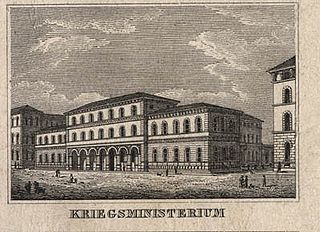
Franz, Duke of Bavaria is head of the House of Wittelsbach, the former ruling family of the Kingdom of Bavaria. His great-grandfather King Ludwig III was the last ruling monarch of Bavaria until deposed in 1918.

Johann von Lamont FRSE, also referred to as Johann Lamont, was a Scottish-German astronomer and physicist.

The Walhalla is a hall of fame that honours laudable and distinguished people in German history – "politicians, sovereigns, scientists and artists of the German tongue"; thus the celebrities honoured are drawn from Greater Germany, a wider area than today's Germany, and even as far away as Britain in the case of several Anglo-Saxons who are honoured. The hall is a neo-classical building above the Danube River, in Donaustauf, east of Regensburg in Bavaria.

The Prince-Bishopric of Würzburg was an ecclesiastical principality of the Holy Roman Empire located in Lower Franconia west of the Prince-Bishopric of Bamberg. Würzburg had been a diocese since 743. As definitely established by the Concordat of 1448, bishops in Germany were chosen by the canons of the cathedral chapter and their election was later confirmed by the pope. Following a common practice in Germany, the prince-bishops of Würzburg were frequently elected to other ecclesiastical principalities as well. The last few prince-bishops resided at the Würzburg Residence, which is one of the grandest baroque palaces in Europe.

The Prince-Bishopric of Eichstätt was a small ecclesiastical principality of the Holy Roman Empire. Centered on the town of Eichstätt, it was located in the present-day state of Bavaria, somewhat to the west of Regensburg, to the north of Neuburg an der Donau and Ingolstadt, to the south of Nuremberg, and to the southeast of Ansbach.

The Kingdom of Bavaria was a German state that succeeded the former Electorate of Bavaria in 1805 and continued to exist until 1918. The Bavarian Elector Maximilian IV Joseph of the House of Wittelsbach became the first King of Bavaria in 1805 as Maximilian I Joseph. The crown would go on being held by the Wittelsbachs until the kingdom came to an end in 1918. Most of Bavaria's present-day borders were established after 1814 with the Treaty of Paris, in which Bavaria ceded Tyrol and Vorarlberg to the Austrian Empire while receiving Aschaffenburg and Würzburg. With the unification of Germany into the German Empire in 1871, the kingdom became a federal state of the new Empire and was second in size, power, and wealth only to the leading state, the Kingdom of Prussia. In 1918, Bavaria became a republic, and the kingdom was thus succeeded by the current Free State of Bavaria.

Prince Adalbert of Bavaria was a member of the Bavarian Royal House of Wittelsbach, historian, author and a German Ambassador to Spain.

Joseph Charles, Hereditary Prince of Sulzbach was the eldest son of Theodore Eustace, Count Palatine of Sulzbach.

Joseph Anton von Maffei was a German industrialist. Together with Joseph von Baader (1763–1835) and Baron Theodor Freiherr von Cramer-Klett (1817–1884), Maffei was one of the three most important railway pioneers in Bavaria.

The Ministry of War was a ministry for military affairs of the Kingdom of Bavaria, founded as Ministerium des Kriegswesens on October 1, 1808 by King Maximilian I Joseph of Bavaria. It was located on the Ludwigstraße in Munich. Today the building, which was built by Leo von Klenze between 1824 and 1830, houses the Bavarian public record office, Bayerisches Hauptstaatsarchiv und Staatsarchiv München.

Princess Amélie Louise d'Arenberg, full German name: Amalie Luise, Prinzessin und Herzogin von Arenberg and full French name: Amélie Louise, princesse et duchesse d'Arenberg, was a member of the House of Arenberg by birth and, through her marriage to Duke Pius August in Bavaria, a member of the Palatinate-Birkenfeld-Gelnhausen line of the House of Wittelsbach. Amélie Louise was a grandmother of Empress Elisabeth of Austria through her son Duke Maximilian Joseph in Bavaria.

Lorenz von Westenrieder was a well-known author and historian in Bavaria and a critic of the Elector Karl Theordor and supporter of Maximilian IV Joseph. There are several memorials to him in Munich.

Karl August Joseph Maria, Count of Donat Seinsheim was the Bavarian Finance Minister and President of the Bavarian Chamber of Deputies.

The Order of Merit of the Bavarian Crown was an order of merit of the Kingdom of Bavaria established by King Maximilian Joseph I on 19 March 1808. The motto of the order is Virtus et Honos. The order was awarded in several grades: Grand Commander, Grand Cross, Commander, Knight, and medals in gold and silver.

Princess Maria Anna of Hesse-Homburg was a German noblewoman. She was the most senior woman at the Prussian court from 1810–40. She was styled as "Princess Wilhelm of Prussia".

Franz Erwein, Count of Schönborn-Wiesentheid was a German art collector and politician from the House of Schönborn.
Johann Lothar Freiherr von Faber was a German industrialist.
The Concordat of 24 October 1817 was a concordat signed on 24 October 1817 between the Kingdom of Bavaria and the Holy See.
This page is based on this
Wikipedia article Text is available under the
CC BY-SA 4.0 license; additional terms may apply.
Images, videos and audio are available under their respective licenses.















